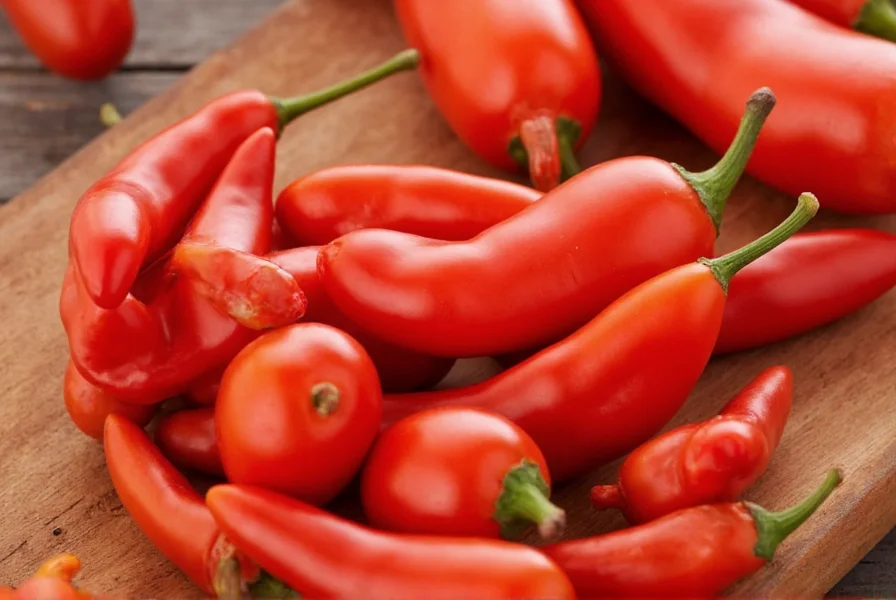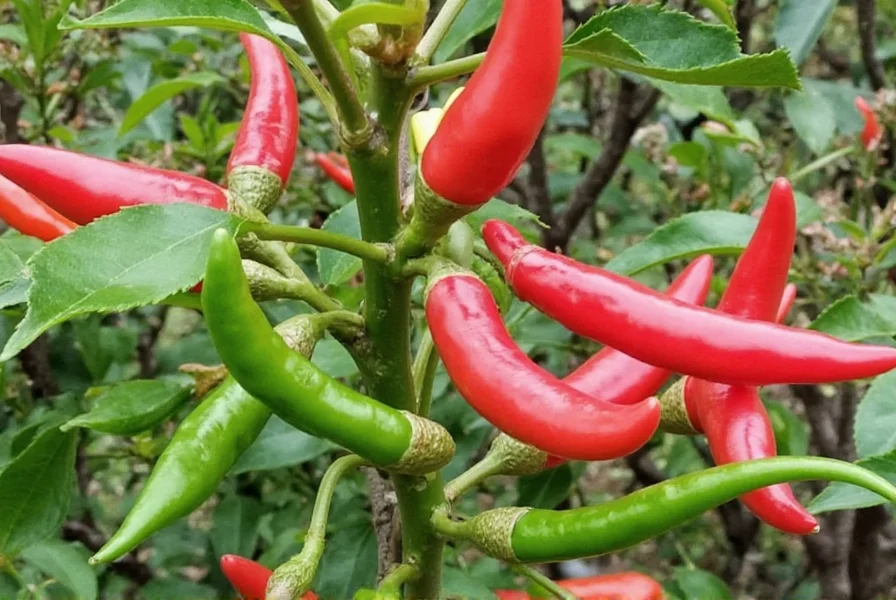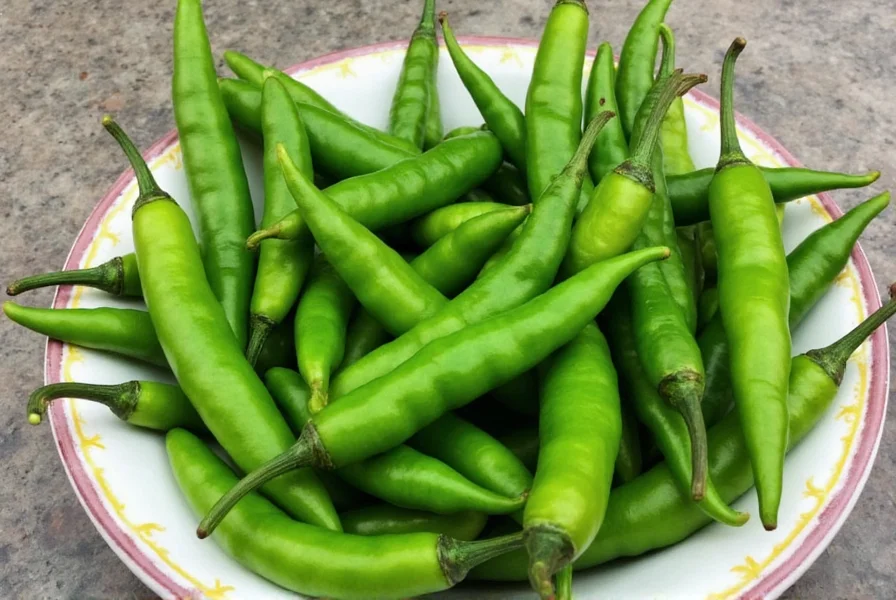Table of Contents
Introduction to Serrano Chile
The Serrano chile is a staple in Mexican and global cuisines, prized for its vibrant green color, balanced heat (5,000-15,000 Scoville units), and fresh, grassy flavor. Unlike its jalapeño cousin, the Serrano offers a brighter, more intense heat profile that elevates salsas, marinades, and sauces. This guide covers everything you need to know about selecting, using, and storing Serrano chiles for optimal culinary results.

Characteristics of Serrano Chiles
Serrano chiles are slender peppers measuring 3-4 inches long with smooth, glossy skin. When immature, they appear bright green; as they ripen, they transition to red, orange, or yellow hues. The heat level varies based on growing conditions and maturity, with green Serranos typically milder than fully ripe red ones. Unlike jalapeños, Serranos maintain consistent thickness along their length and have a distinctive tapered tip. Their flavor profile combines mild sweetness with a sharp, grassy tang that enhances dishes without overwhelming them.
Practical Tips for Using Serrano Chiles
Whether you're a beginner or experienced cook, these expert tips will help you maximize Serrano chile flavor:
- Control heat by removing seeds and membranes - The highest concentration of capsaicin resides in the white membranes and seeds. Removing these components reduces spiciness while preserving flavor.
- Cook to mellow heat and enhance sweetness - Roasting, grilling, or sautéing Serranos brings out their natural sugars and softens their texture for salsas, sauces, and stews.
- Pair with complementary ingredients - Balance heat with acidity (lime juice), creaminess (avocado, sour cream), or sweetness (pineapple, mango) for harmonious dishes.
- Preserve freshness properly - Store unwashed chiles in a paper bag in the refrigerator crisper drawer for up to 2 weeks. For long-term storage, freeze whole or chopped chiles in airtight containers for up to 6 months.
- Use fresh for maximum impact - While dried Serranos exist, fresh chiles provide superior texture and bright flavor for most applications like salsas and garnishes.

Buying Guide: How to Choose the Best Serrano Chiles
Follow these expert guidelines to select the highest quality Serrano chiles:
- Look for firmness and shine - Avoid chiles with wrinkles, soft spots, or dull skin. The surface should feel smooth and taut when gently squeezed.
- Check stem integrity - Fresh chiles have green, intact stems. Brown or shriveled stems indicate age and reduced freshness.
- Consider color for flavor profile - Green Serranos offer grassy, bright heat perfect for salsas; red ones provide sweeter, fruitier notes ideal for sauces and stews.
- Source from reputable suppliers - Farmers' markets and specialty produce stores typically offer fresher, higher-quality chiles than standard grocery stores.
- Understand heat variation - While Serranos generally range 5,000-15,000 Scoville units, individual peppers can vary. When possible, ask vendors about heat levels for specific batches.
| Chile Type | Heat Level (Scoville Units) | Flavor Profile | Best Uses |
|---|---|---|---|
| Serrano | 5,000–15,000 | Mildly sweet, grassy, tangy | Salsa, tacos, stews, pickling |
| Jalapeño | 2,500–8,000 | Earthy, slightly sweet, smoky | Pickling, salsas, stuffed peppers |
| Chipotle | 2,500–8,000 | Smoky, earthy, rich | Smoked salsas, barbecue sauces, stews |
| Ghost Pepper | 850,000–1,000,000 | Very hot, fruity, sometimes floral | Spicy snacks, sauces, challenges |
| Padrón | 500–1,000 | Mildly sweet, nutty, grassy | Tapas, frying, grilling |

Frequently Asked Questions About Serrano Chiles
How can I identify a Serrano chile from other peppers?
Serrano chiles are easily identified by their slender, 3-4 inch length with consistent thickness along the body and a tapered tip. Unlike jalapeños which are shorter and bulbous at the base, Serranos maintain uniform width. They have smooth, glossy skin (often with fine striations) and bright green color when immature, turning red, orange, or yellow when ripe. The stem is typically small and green.
What's the difference between green and red Serrano chiles?
Green Serranos are harvested earlier and have a brighter, grassier flavor with slightly more pronounced heat. Red Serranos are fully ripe and develop sweeter, fruitier notes while maintaining similar heat levels. Both are equally versatile, but red varieties work particularly well in cooked dishes where their sweetness can balance rich flavors.
Can I substitute jalapeños for Serrano chiles in recipes?
Yes, but with adjustments. Serranos are typically 2-3 times hotter than jalapeños, so use 1/2 to 2/3 the amount when substituting. For salsas and fresh applications, Serranos provide brighter flavor; for smoked dishes, chipotles might be better. Always taste as you go when substituting to control heat levels.
How do I safely handle Serrano chiles?
Always wear gloves when handling fresh chiles to prevent skin irritation. Avoid touching your face, especially eyes. After handling, wash hands thoroughly with soap and warm water. If you accidentally get capsaicin on your skin, use rubbing alcohol or milk to neutralize the burn. For sensitive individuals, consider using kitchen shears to cut chiles instead of handling them directly.
What's the best way to store Serrano chiles?
For short-term storage (up to 2 weeks), keep unwashed chiles in a paper bag inside the refrigerator crisper drawer. For longer storage (up to 6 months), freeze whole or chopped chiles in airtight containers or freezer bags. Never store chiles in plastic bags as moisture buildup accelerates spoilage. For dried chiles, store in a cool, dark place in an airtight container for up to 1 year.
Are Serrano chiles good for weight loss?
Yes, Serrano chiles can support weight management. Capsaicin, the compound responsible for heat, has been shown to temporarily boost metabolism and reduce appetite. They're low in calories (just 18 calories per 100g) and high in vitamin C and antioxidants. However, they should be part of a balanced diet - the heat alone won't cause weight loss but can enhance flavor without adding calories to dishes.
Conclusion
Serrano chiles offer a perfect balance of heat and flavor that elevates countless dishes worldwide. Whether you're making fresh salsa, marinating meats, or adding spice to soups, understanding how to select, prepare, and store these versatile peppers ensures optimal results every time. With proper handling techniques and knowledge of their unique characteristics, Serrano chiles can become an indispensable ingredient in your culinary toolkit.
Remember: the key to mastering Serrano chiles is practice. Start with small amounts when experimenting with new recipes, and gradually adjust to your preferred heat level. Their bright, grassy flavor profile makes them ideal for both traditional Mexican dishes and innovative global cuisine applications.










 浙公网安备
33010002000092号
浙公网安备
33010002000092号 浙B2-20120091-4
浙B2-20120091-4